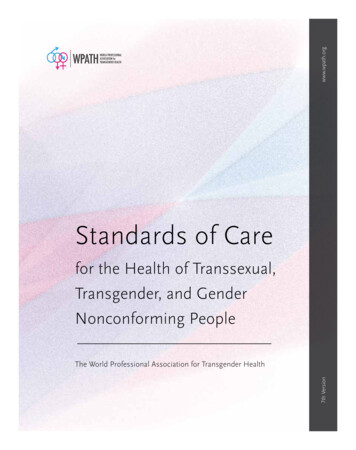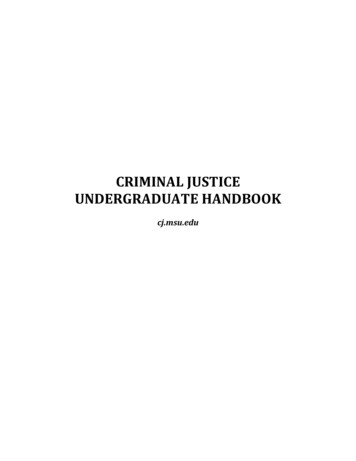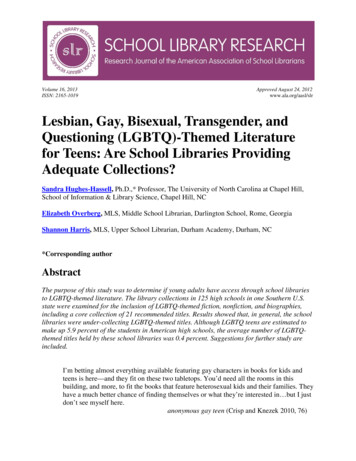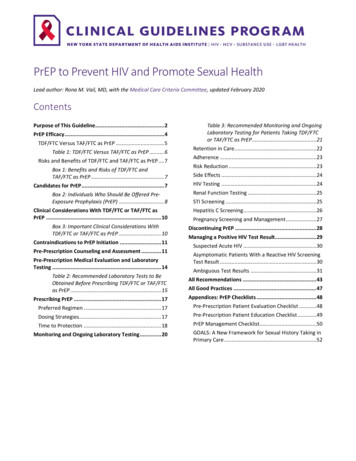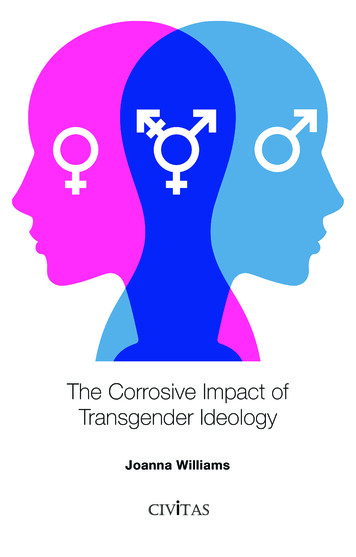
Transcription
The Corrosive Impact ofTransgender IdeologyJoanna Williams
The Corrosive Impact ofTransgender Ideology
The Corrosive Impact ofTransgender IdeologyJoanna Williams
First publishedJune 2020 Civitas 202055 Tufton StreetLondon SW1P 3QLemail: books@civitas.org.ukAll rights reservedISBN 978-1-912581-08-5Independence: Civitas: Institute for the Study of CivilSociety is a registered educational charity (No. 1085494)and a company limited by guarantee (No. 04023541).Civitas is financed from a variety of private sources toavoid over-reliance on any single or small group of donors.All the Institute’s publications seek to further its objectiveof promoting the advancement of learning. The viewsexpressed are those of the authors, not of the Institute.Typeset by TypetechniquePrinted in Great Britainby 4edge Limited, Essexiv
ContentsAuthorviSummaryviiIntroduction11. Changing attitudes towards sex and gender32. The impact of transgender ideology173. Ideological y89Notes97v
AuthorJoanna Williams is director of the Freedom, Democracyand Victimhood Project at Civitas. Previously she taughtat the University of Kent where she was Director of theCentre for the Study of Higher Education. Joanna is theauthor of Women vs Feminism (2017), Academic Freedom in anAge of Conformity (2016) and Consuming Higher Education,Why Learning Can’t Be Bought (2012). She co-edited WhyAcademic Freedom Matters (2017) and has written numerousacademic journal articles and book chapters exploring themarketization of higher education, the student as consumerand education as a public good. In addition, Joanna haswritten about education, feminism and gender for manypopular outlets including the The Spectator, The Sun, TheTelegraph and American Conservative. Joanna is a regularcolumnist for the online magazine Spiked.vi
SummaryIn less than two decades ‘transgender’ has gone from aterm representing individuals and little used outside ofspecialist communities, to signifying a powerful politicalideology driving significant social change. At the levelof the individual, this shift has occurred through theseparation of gender from sex, before bringing biology backin via a brain-based sense of ‘gender-identity’. This returnto biology allows for the formation of a distinct identitygroup, one that can stake a claim to being persecuted, anddepends upon continual validation and confirmation froman external audience. All critical discussion is a threat to thispublic validation and it is often effectively curtailed.However, this is only half of the story. The total number oftransgender individuals remains tiny. That transgenderismhas moved from niche to mainstream tells us more about therest of society than it does about transgender individuals.People in positions of power within the realms of media,education, academia, police, social work, medicine, law,and local and national government have been preparedto coalesce behind the demands of a tiny transgendercommunity. Previously authoritative institutions nowlack confidence in their own ability to lead and look to thetransgender community as a victimised group that can actas a source of moral authority. However, this, in turn, erodessex-based rights and undermines child protection.vii
T H E C O R R O S I V E I M PA C T O F T R A N S G E N D E R I D E O L O G YThe expansion of transgender rights has gone hand inhand with an expansion of state and institutional (bothpublic and private) regulation of speech and behaviour.This highlights a significant difference between today’stransgender activists and the gay rights movement ofa previous era. Whereas the gay rights movement wasabout demanding more freedom from the state for peopleto determine their sex lives unconstrained by the law, thetransgender movement demands the opposite: it calls forrecognition and protection from the state in the form ofintervention to regulate the behaviour of those outside ofthe identity group. Whereas in the past, to be radical wasto demand greater freedom from the state and institutionalauthority, today to be radical is to demand restrictions onfree expression in the name of preventing offence.Recommendations1. Both the UK Government and the Scottish Parliamentshould announce a moratorium on all reform of theGender Recognition Act for at least the duration of thisparliament.2. The Government should clarify the distinction betweensex-based and gender-based protections as set out in theEqualities Act 2010. The Act’s permission for sex-baseddiscrimination to preserve female-only services shouldbe reiterated.3. The prescribing of puberty blockers and cross-sexhormones to anyone under the age of 18 should beimmediately prohibited.viii
S U M M A RY4. No child should be permitted to ‘socially transition’ atschool (i.e. change name, pronouns, uniform or use thechanging rooms and toilets intended for members of theopposite sex) without the permission of their parents.5. Schools should be encouraged to separate out theteaching of lesbian, gay and bi-sexual relationships fromteaching about transgender as part of the Relationshipsand Sex Education curriculum. Teaching on transgendershould not contradict the content of the science/biologycurriculum.ix
x
IntroductionThis report explores the social impact of changedunderstandings of gender and, in particular, the emergenceof the idea of transgender. A new orthodoxy that genderidentity is brain-based and innate, something we need todiscover for ourselves and then reveal to a readily acceptingworld, has rapidly gained ground. This seemingly benignview has consequences for how we socialise children andorganise society. It calls into question sex-protected rightsand freedom of association. The existence of female-onlyprisons and refuges or girls’ schools, clubs and sports isthrown into doubt. Yet far from engaging in a free and opendiscussion, transgender activists have moved to curtaildebate. The consequences of this and the impact it has onthe lives of women and children are detailed here.We draw a distinction between transgenderism andtransgender individuals. The term transgenderism is used torefer to an ideological movement that challenges sex-basedrights and actively promotes the idea that a person’s genderidentity has no connection to their anatomy. This politicalagenda has been embraced by activists and campaigningorganisations. As a movement, it has proven to be far moreinfluential than a numerical count of transgender individualsmay suggest. Transgenderism has come to be not just acceptedbut often promoted in key public institutions such as education,health care, social work, the police and prison service.1
T H E C O R R O S I V E I M PA C T O F T R A N S G E N D E R I D E O L O G YAt the same time, not all transgender individuals supportthis broader ideological movement and some may refer tothemselves as transsexuals in a bid to emphasise the realityof immutable sex. Nonetheless, the rise of transgenderismcan be linked to an increase in the number of transgenderindividuals and, crucially, a change in the population mostlikely to identify as transgender. Where once counsellorswere mainly approached by middle-aged men with apersonal history of cross-dressing, today it is teenage girlswho are most likely to seek advice with transitioning.Institutions that have been captured by an ideology oftransgenderism are unable to defend the sex-based rightsof women or to protect children who mistakenly considerchanging gender as the solution to a range of personal orsocial problems they may be experiencing.This report explores the reasons for the rise oftransgenderism and the impact it has on the lives of womenand children. It is in three parts. Chapter one considerschanging attitudes towards sex and gender. It explains howwe have moved, over a period of around a century, from aview that sex determines personal qualities and prescribessocial roles, though to a more liberal understanding ofgender as socially constructed and grounded in stereotypesthat can be challenged, before returning once more to adeterminism now based not on sex but on a person’s innatesense of gender identity. Chapter two explores the impactof this shift in thinking upon the lives of children andwomen. Finally, the third chapter of this report considershow and why the ideological capture of institutions hasbeen so successful. This report concludes with policyrecommendations designed to safeguard the rights ofwomen and children and to pause a debate that is nowmarked more by heat than light.2
1.Changing attitudes towardssex and genderFrom sex to genderBeliefs about sex and gender have changed over time.Throughout most of human history there has been noconcept of gender: it was assumed that sex determinedeverything about a person. Men, considered physicallystrong, intelligent and stoical, were best suited to manualwork or roles in the public sphere; women, meanwhile,were apparently physically weaker but more caring andnurturing, best suited to domestic roles. These perceiveddifferences shaped legal rights and social expectations.From the late eighteenth century onwards, thinkers such asMary Wollstonecraft began to question whether women werenaturally inferior to men or whether society, most notablythrough differences in upbringing and education, made malesand females intellectually, emotionally and even physicallydifferent from one another.1 This view was developed bySimone De Beauvoir who wrote in The Second Sex (1949) that,‘One is not born, but rather becomes, a woman.’2 De Beauvoir’sargument was not that people were born sex-less but that themeaning given to sex, in particular to being female, is createdwithin a particular social context. People are born male orfemale but the values and qualities attached to being a man ora woman are determined by the dominant culture of an era.3
T H E C O R R O S I V E I M PA C T O F T R A N S G E N D E R I D E O L O G YAt the time De Beauvoir was writing, the concept of‘gender’ did not exist as a synonym for sex. The psychologistJohn Money was, in 1955, the first to use the word gender todraw a distinction between sex, or the physical and biologicalattributes that distinguish males and females, and thebehaviour and attitudes people demonstrate. Money positedthat sex bore little relationship to gender. He took particularinterest in children born intersex, that is, with indeterminategenitalia, and argued that it was the child’s socialisation thatdetermined whether they grew up as a man or a woman, notwhether they were born male or female. Taking this positionto its logical conclusion, Money suggested that a baby bornwith male genitalia who underwent surgery to alter thesesex characteristics and was subsequently raised as a girl,could go on to live successfully as a woman.Indeed, Money not only proposed this as a theory butput his idea into practice with a baby boy, David Reimer,who had suffered surgical trauma to his penis.3 His parentswere simply instructed to go away and raise a girl: their son,David, became their daughter, Brenda. The results of thisexperiment were initially recorded as successful. However,many years later, as an adult, Brenda re-transitioned to maleand spoke out about the distress the experiment had causedhim. He tragically committed suicide aged just 38.Money’s experiments help locate the emergence of atransgender identity within the medical profession. AsHodson suggests, ‘It became possible to conceptualise“gender identity” as dislocated from biological sexwhen new medical technologies for the first time madeit possible for doctors to change the bodies of those bornwith indeterminate genitals and to assign them to a sex.’4 Inthis way, ‘the availability of the treatment appears to haveessentially created the demand.’54
C H A N G I N G AT T I T U D E S T O WA R D S S E X A N D G E N D E RIt was not until the 1970s that the word ‘gender’ began toenter mainstream vocabulary. It took off with the emergenceof second wave feminism and the debate it instigated aboutthe rigid and sharply distinct social roles expected of menand women. Gender became a useful way to distinguishbetween the fact of being female and the performance ofwomanhood shaped by social expectations. Neither DeBeauvoir nor the feminists of the 1970s denied the existenceof sex, nor that individuals born female became womenwhile those born male became men. Rather, feminists suchas Germaine Greer sought to challenge the assumption thatbeing female meant conforming to an invented and sociallyimposed set of (gendered) expectations.6 The creation ofgender allowed for a critique of masculine and femininestereotypes; it did not lead automatically to the conclusionthat some people were transgender.Gender as performanceThird wave feminism was shaped, in part, by critical theoryand post-structuralism – ideas that emerged from insideuniversities rather than among political campaigners. Theapplication of post-structuralist thinking to ideas about sexand gender led to the view that gendered-performance –whether a person presents and acts in a way that is perceivedas masculine or feminine – serves as a signifier of theirbiological sex. What is being signified (sex) is no more ‘true’or ‘real’ than the performance; both are socially constructed.The connection between sex and gender came to be seenas increasingly arbitrary. Judith Butler, writing in GenderTrouble (1988) argued not just that ‘gender is performative,’7but that there is no biological reality, no greater truth,underpinning the performance: ‘“being” a sex or a gender isfundamentally impossible’.85
T H E C O R R O S I V E I M PA C T O F T R A N S G E N D E R I D E O L O G YFor Butler, there is only performance and no ‘real reality’.She criticises what she sees as the false assumption that‘there is a natural or biological female who is subsequentlytransformed into a socially subordinate “woman”, withthe consequence that “sex” is to “nature” or “the raw” asgender is to culture or “the cooked.”’9 Butler argues thatthe biological female is ‘a discursive formation that acts as anaturalized foundation for the nature/culture distinction andthe strategies of domination that the distinction supports.’10For Butler, gender is simply ‘a kind of persistentimpersonation that passes as the real,’11 and in order topass as real the performance, or impersonation, needs anaudience. Gender thus becomes a ‘relational term’ forgedin the process of interaction and with no fixed referent.12In other words, ‘what we take to be an internal essence,’ isactually ‘manufactured through a sustained set of acts.’13Significantly, for Butler, unlike for Greer or De Beauvoir,not only is there no ‘essence,’ there is also no agent that isresponsible for shaping the performance: ‘Gender is alwaysa doing, though not a doing by a subject who might be saidto preexist the deed.’14 Rather than sex preceding gender,Butler argues it is our social and cultural views on genderthat construct sex: ‘Gender is not to culture as sex is to nature’she explains, ‘gender is also the discursive/cultural meansby which “sexed nature” or “a natural sex” is produced andestablished as “prediscursive,” prior to culture, a politicallyneutral surface on which culture acts.’15Today, following Butler, sex has been rejected by manyradical thinkers as an outdated concept that has no morebasis in material reality than gender. As a result, theperformance of gender floats freely from biology: both areconsidered equally arbitrary. Gender can now be conceivedas fluid and multiple. People are not assumed to be born6
C H A N G I N G AT T I T U D E S T O WA R D S S E X A N D G E N D E Rmale or female but randomly assigned membership ofa culturally prescribed sex category in an act of symbolicviolence conducted at the moment of birth. (See, forexample, Labour MP Dawn Butler’s statement that babiesare born without sex).16 Some people will be socialised intoaccepting this arbitrary category and will dutifully performthe appropriate gender. For others, the conflict will provetoo much and they will be unable to comply. These peopleare, according to the theorists, transgender or ‘gender queer’.When the relationship between sex and gender isconsidered arbitrary, ‘It is the perception that the baseproperty (or properties) is present that matters . not theactual presence of it,’17 or, in other words, it is the perceptionthat someone is male or female that determines how othersrespond to them and the gender that is then conferredupon them, rather than their actually being male or female.Primary and secondary sex characteristics are significantonly in the sense that their presence (or absence) creates aperception that others respond to.Following the logic of Butler’s theory, Asta arguesgender precedes and constructs sex: ‘the schemas of genderdetermine what bodies and body parts get sexed.’18 As aresult, gender becomes freed from biology only for anatomyto be tied to public perception: ‘To be of a certain gender, forexample, is to be taken to have bodily features presumedto be evidence of a role in biological reproduction and beplaced in a hierarchical power structure as a result.’19 Whengender is understood to be distinct from sex, and bothcategories are constructed through a socially inscribedperformance, then the responses and attitudes of othersto that performance become all important. When thereis no biology underpinning gender and there is no agentdetermining the performance then the performance itself,7
T H E C O R R O S I V E I M PA C T O F T R A N S G E N D E R I D E O L O G Yand the interaction it compels, is all. As Asta puts it, ‘If youare taken to identify with being a woman in a context, youare a woman in that context.’20 This emphasis on perceptiongoes some way towards explaining why leading figures inthe transgender movement are so concerned with compellingparticular language use and enshrining in law the rightsof transgender women to access spaces and opportunitiesreserved exclusively for females.Bringing biology back inMost recently, there has been a shift in thinking aboutgender that heralds a renewed focus on biology. This is nota return to the idea that sex is inscribed in chromosomes,hormones and genitalia but a shift towards understandinggender identity, an internal sense of being male or female,as being ‘hardwired into the brain at birth.’21 One theory isthat this process of ‘hardwiring’ occurs through prenatalexposure to abnormal levels of sex hormones or endocrineinfluences linked with the developing brain’s sensitivity toandrogen and testosterone secretions in utero. However,there is little scientific evidence to support this proposition.There are generally thought to be some differencesbetween male and female brains. Subcortically, theamygdala is larger in men and has a higher density ofandrogen than oestrogen receptors, whereas portions of thehippocampus are larger in women, with a higher densityof oestrogen than androgen receptors.22 Sex differences inbrain morphology, connectivity, and function are thoughtto underlie sex differences in behaviour, psychopathology,and cognitive performance on certain tasks. In general, menhave less trouble with visuospatial tasks, whereas womenoutperform men in verbal fluency tasks. Sex differences inbrain activation during mental rotation exercises have also8
C H A N G I N G AT T I T U D E S T O WA R D S S E X A N D G E N D E Rbeen shown: men show predominantly parietal activation,while women additionally show more interior frontalactivation.23It is worth noting that differences in the brain are, likeheight and weight, on a continuum rather than beingmarked by a clear distinction. This means that attempts todemarcate male and female brains rely upon averages andjust as some women may be taller than some men, likewisesome women may have a larger than average amygdala andsome men a larger than average hippocampus. As a result,there is little consensus about either the exact nature or thesignificance of differences between male and female brains.Scientists have failed to establish a definitive model of asexed brain. Stephanie Davies-Arai, founder of TransgenderTrend, explains that:‘Conclusions drawn from brain scans are vastly overblown.It’s not that men and women are exactly the same becausethere are average differences in some areas. But thoseaverage differences mean that, for example, it is only about60% likely that someone who is good at spatial reasoningwill be male – and of course an individual woman may scorehigher on this count than an individual man. In every aspectof life, there’s nature and nurture, boys and girls are treateddifferently even before they are born.’24The cognitive neuroscientist Cordelia Fine mounts a strongchallenge to what she labels as the ‘neurosexism’ thatportrays attributes such as intelligence, spatial awarenessand empathy as differentially hardwired into male andfemale brains.25The desire to locate a difference between male and femalebrains that compels a difference in personality and behaviourwas once driven by conservative thinkers in search of anaturalised explanation for gender differences. Today,9
T H E C O R R O S I V E I M PA C T O F T R A N S G E N D E R I D E O L O G Yconservative thinkers are joined by those who considerthemselves to be at the forefront of challenging society’sviews on gender. One reason for this is that the existence ofa sexed brain paves the way for the view that some peoplecan be born with a biological disjuncture between brain andbody making transgender a form of intersex located withinthe brain.At present, intersex is defined specifically as a conditionin which chromosomal sex is inconsistent with phenotypicsex, or in which the phenotype is not classifiable aseither male or female. Far from being fairly common, astransgender activists suggest, the phenomenon of intersexoccurs in fewer than 2 out of every 10,000 births.26 Just asan intersex person is born with mixed or indeterminategenitalia, or having mixed or indeterminate chromosomesand phenotype, so it is argued a fetus may develop with amale brain and a female body or vice versa. If this happensthen, apparently, incongruence can exist between a person’sinternal sense of being male or female and their externalanatomical sex characteristics.The search for a sexed brain has morphed into the searchfor a transgender brain. Sex-typical cognitive abilitieshave been studied in people with gender incongruence todetermine whether they show performance and activationpatterns like their natal sex or gender identity. In one mentalrotation study, transgender women (assigned male at birth)differed from a control groups of males in brain activation:the control men showed greater activation in the left parietalregion, while untreated and hormone-treated transgenderwomen exhibited stronger activation in the temporaloccipital regions.27 One neuroimaging study showed that‘gray matter volumes of adolescents with gender dysphoriaare, on a whole brain level, in line with their natal sex, but10
C H A N G I N G AT T I T U D E S T O WA R D S S E X A N D G E N D E Rwhen analyses are done in regions of interest, there is someindication for sex atypical differentiation.’28 A third studysuggests genetic involvement in the development of genderincongruence, meaning that the brains of people with earlyonset gender incongruence show a gross morphologysimilar to their natal sex but white matter microstructureis demasculinized in transgender women (natal male) andmasculinized in transgender men (natal female).29The existence of a ‘transgender brain’ remains highlycontested. It is fundamentally premised upon the existenceof a sexed brain which, as we have seen, is also contested.Even if we do accept that male and female brains differ,there is no evidence of a complete sex reversal in the brainstructures of people with gender incongruence. Not onlyhave few studies been conducted but in those that have,techniques, design and samples are very diverse making itdifficult to draw firm conclusions or to replicate findings.Furthermore, the relationship between cause and effect isnot straightforward: it might be the case that people whocome to believe they are a different gender to their natal sexmay exhibit behaviours stereotypically associated with theiradopted gender which in turn shows up in neuro-imaging.To a certain extent, whatever brain scans do or do not showis of little relevance in understanding social attitudes. AsDavies-Arai makes clear: ‘We don’t define men and womenby their brains. Doing so would be essentialist and thelogical conclusion is frightening: will we introduce braintests to see who is really a boy and who is really a girl?’30The UK’s Department of Health (DoH) confirms that ‘thereis no physical test for detecting gender variance that maydevelop into adult dysphoria.’ Yet rather than concludingfrom this assertion that transgender is a social ratherthan biological condition, the Department suggests that11
T H E C O R R O S I V E I M PA C T O F T R A N S G E N D E R I D E O L O G Y‘clinicians must rely on the young person’s own account.’31Because ‘“brain sex” is not readily apparent,’ it is arguedthat ‘transgender people must be believed about who theyare.’32 This emphasis on belief suggests that transgenderpeople can detect a biologically inscribed male or femaleessence – a skill denied to the overwhelming majority of thepopulation.Whatever neuro-imaging may purport to show, a femalewho can read a map is clearly no more a man than a malewho can iron a shirt is a woman. As Davies-Arai argues,‘It’s a political idea that we have a sense of gender identitywhich exists independent of both our biological sex and ourgendered socialisation.’33 Yet transgender activists continueto promote the idea that people are born with a gender; or,in other words, that humans emerge into the world with afully formed male soul or female essence – or even a nonbinary, genderless essence – that is located within our bodiesor our brains. According to this way of thinking, genderis an innate sense we have of ourselves that is entirelyindependent of both anatomy and social expectation. AsDavies-Arai explains, ‘This idea is really contentious. Howcan we be born with a fully-formed, intact idea of our ownidentity?’34 The logical consequence of this view returns usto a pre-Wollstonecraft sense that biology is destiny: onlynow it is our gendered essence, rather than our genitalia,that determines our life course.The shift from exploring the physical attributes of maleand female brains to detecting a gendered-essence takesus from sketchy and inconsistent evidence into the terrainof pure fantasy. Gender is a socially constructed property;that is, it is dependent on human thoughts, attitudes andpractices. The idea that a socially constructed concept canbe biologically inscribed within the structure of the brain12
C H A N G I N G AT T I T U D E S T O WA R D S S E X A N D G E N D E Rand only transgender individuals themselves are able tounlock and interpret the inscriptions makes little sense. Theimpact of society and culture in shaping people’s actions iscompletely overlooked. As Alice Dreger puts it, ‘whetheryou end up living as an out gay man, a closeted gay man, ora straight transgender woman depends not only on biology,but also on cultural tolerance of various identities.’35Gender dysphoriaDespite the absence of evidence, gender theorists andtransgender activists continue to promote the view that thereare two quite distinct sets of biological sex characteristics:outer, anatomical characteristics and an inner sense of genderidentity. For some people, inner and outer sex characteristicsare aligned (these people are labelled ‘cis-gendered’ bytransgender activists keen to challenge the idea that thereis a ‘normal’ relationship between sex and gender) but fortransgender people, inner and outer sex characteristicsconflict. This conflict, present even prior to the moment ofbirth, may lead to a condition known as gender dysphoria,or ‘the ongoing distress that arises from the incongruity ofassigned sex at birth and internal experience of gender.’Gender dysphoria is listed in the Diagnostic and StatisticalManual of Mental Disorders, version 5 (DSM-5)36 althoughthis has proved controversial as activists argue that beingtransgender is not a mental disorder.It is advantageous for activists to promote the idea thatpeople are born with an internal sense of gender identity.It suggests that being transgender is not simply a choice;just as we have come to understand in relation to sexuality,transgender people are simply ‘born this way’. This assertionis used to claim that transgender people have always existedand it is only now that that there is greater awareness and13
T H E C O R R O S I V E I M PA C T O F T R A N S G E N D E R I D E O L O G Yacceptance that they can finally can be their ‘true selves’. Theclaim to have been ‘born this way’ now forms the basis for acollective identity. To be transgender is not just to make anindividual claim but to stake a claim to group membership.Biology-based groupings were once rejected by a previousgeneration of activists who sought to distance themselvesfrom what they considered to be reductionist perceptions ofwho they were and what they could become. As academicTerry Murray points out, they urged others not to define themby reference to genitalia, skin colour or group stereotypes. Incontrast, ‘today’s transgender activists demand recognition oftheir allegedly innate difference, believing that membershipin a biologically or essentially distinct group should entitlethem to civil rights and legal recognition.’37Far from being a naturally occurring phenomenon thathas existed across space and time, transgenderism – anideology that promotes the view that everyone has a t
of immutable sex. Nonetheless, the rise of transgenderism can be linked to an increase in the number of transgender individuals and, crucially, a change in the population most likely to identify as transgender. Where once counsellors were mainly approached by middle-aged men with a pers

